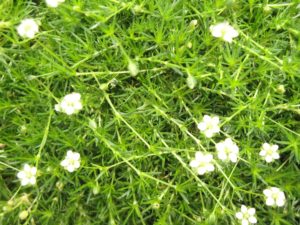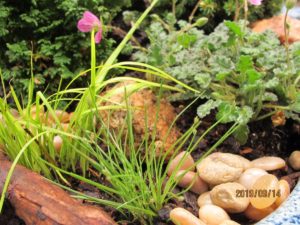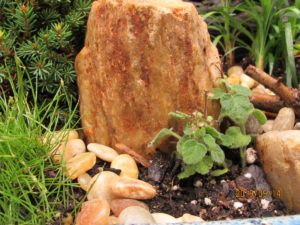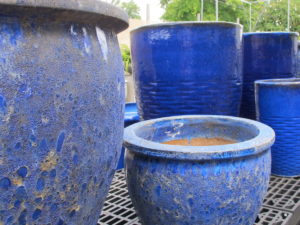Page 2
Tips For Potting Up the Miniature Garden
A pot that’s wider at the top and doesn’t curve inward (the deep blue pots in photo above) allows freezing soil to push up in the pot as it expands, without breaking it. The smoother the interior, the better. It might not work every time, though.
Water exerts substantial pressure as it freezes, so consider how it behaves and what it can do to your pots. If you’ve ever had to deal with burst frozen pipes, you’re familiar with this phenomenon.
When planting winter combination pots, I included thin sheets of styrofoam (saved from cases of shipped plants) on part of the inside walls and especially in the curved shoulders of ceramic pots chosen by my customers. A pocket of air between the pot and the soil, held open by the styrofoam, gave the expanding soil somewhere to go without putting much pressure on the pot itself. And, again, it won’t work every time.
Clay pots, which absorb water, eventually will crack or spall when exposed to freeze/thaw cycles. I sometimes use them outdoors in winter anyway, knowing that they will fail one of these years.
Double-Potting
Now, you could avoid all this fuss by choosing plastic pots instead. But, if you want the look of glazed pottery, another option is double-potting the planter.
Instead of planting directly into the ceramic pot, keep the plants in a plastic pot that is then placed inside the ceramic one. Raise it to the proper level with bricks or an inverted pot. Use mulch or moss to hide the plastic, and make sure that any water inside the ceramic pot can drain out.
Plants For the Miniature Garden
Bloomers
Several wagons holding flats of violas, pansies, and snapdragons lined up in the parking lot of the garden center. Fall color! I bought 2 packs of violas in the Sorbet strain—‘Black Delight’ and ‘Lilac Ice’. Here in the Carolinas, a clump of violas in the pot will flower right through the cold winter months. If they outgrow the scale of the miniature garden, I’ll remove them.
Hardy Plants
Other cold-hardy plants for a miniature garden include grassy-leaved miniature Acorus and Ophiopogon (dwarf mondo grass), thyme, miniature Sempervivum (hens and chicks), and gold-leaved Sedum makinoi ‘Ogon’. Sedum dasyphyllum grows very low and has tiny blue-gray leaves.
When composing your container, combine plants that require similar growing conditions. Themes could center around succulents, a shady forest floor, or an alpine meadow. Add appropriate elements (rocks, gravel, driftwood, tiny cones from hemlock) to enhance the landscape.
Take a look in the ground cover and perennials departments at the garden center for more ideas. You might have specialist growers among the vendors at your local farmers’ markets.
I might use a tiny plant that volunteered in a potted perennial I purchased in Maryland about 20 years ago. It grows only 1 1/2-2″ tall and has lilac flowers in late spring and sometimes also later in the season.
Moss

Irish moss, Sagina subulata.
Fine-textured mosses, perfect for miniature gardens, add accents of greenery. A patch of true moss, a fern ally, grows in the moist shade behind the shed. I might add some near the base of the big driftwood.
Green Irish moss and chartreuse Scottish moss also work in miniature gardens. These pearlworts—Sagina subulata (photo, right) and S. s. ‘Aurea’—actually are flowering plants, and not mosses at all. During part of the growing season, they’ll have tiny white blooms held above the ground-hugging foliage.
Pruning
When the plants grow beyond their allotted space, they’ll be snipped back or replaced. Using very slow-growing varieties obviates the need for frequent pruning.
But use caution when clipping those precious evergreens, if you need to do so at all. Conifers don’t branch out again when cut back into old wood, where there are no dormant buds.
When the candles (buds at the tips of the stems) begin to expand in spring, I’ll pinch them shorter to limit the current year’s growth. If this is routinely done, the conifers will stay smaller over their useful life in the potted garden.
The Blue Pot
The empty pot has been cleaned, and a handful of polyester fiberfill placed over the drainage hole. Polyester fiberfill, available at a hobby shop, allows drainage without letting any soil erode through the drainage hole. Because it’s synthetic, it won’t rot. I pulled some of the material through the hole to a point, which might help the soil drain even better.
Potting soil, amended with rich topsoil from the vegetable garden, covers the bottom half of the pot. Now I can move the plants around, still in their pots, for possible design ideas.
The Off-Centerpiece
This time, I chose the major wood element first, and built the garden’s design around it. I thought the piece could overpower the design, but, once it was in place, it looked just right.
It isn’t buried deeply in the soil, so the sturdy root balls of the 3 evergreens will hold it in place until roots grow around it. Remember to firmly pack the soil under and around the base of the natural elements so they won’t shift or settle. The wood won’t last forever, and I’ll replace it when enough of it rots away.
When choosing locations for the major elements in any miniature design—or in your landscape—avoid the temptation to place any of them right in the center of the garden. The exception would be for a geometric par-terre and other symmetrical compositions.
In addition to the vertical off-centerpiece, I set aside more pieces of wood and rocks from my collection. What…you don’t collect interesting rocks and twigs??
There’s a bag of natural gravel in the shed, but I’ll look for some smaller gravel, too. Fine textures are better suited to the scale of a miniature garden. Using gravel in varying sizes mimics natural landscapes.
More Plants For the Miniature Garden
From the garden center, I purchased an Erodium (related to geraniums) with pink flowers, a dwarf mondo grass, and Scottish moss.
Among the plants I already have are dwarf golden Acorus, a small white-variegated Carex conica ‘Snowline’, Eleocharis radicans (miniature fiber optic grass), and that tiny unnamed “weed” (probably a Nepeta, or catmint) mentioned earlier. Clumps of these small players will be divided in order to fit into the miniature garden.
Let’s Start Planting
First to be planted was the ‘Primo’ arborvitae, and then the 2 smaller spruces. The evergreens’ roots tightly filled their pots, so I used scissors to lightly rough up the roots on the surface of the root balls. This encourages the plants to quickly send new roots out into the soil.
Now that the 3 evergreens are in place, it’s time to find a home for the Erodium and the other plants. I moved them around some more and finally found a good layout. Then I removed the potted plants to the work table, arranged in the same layout as they were in the ceramic pot.
One by one, each plant settled into its new home. I added more soil and firmed it in around the root systems, keeping the surface of each root ball flush with the finished soil surface. The surface is only about 1/2″ below the rim of the pot.
When planting a complicated garden such as this, with many moving parts, it’s easy to forget to fill all the gaps with soil. Overlooked pockets will cause low spots and exposed roots as the soil settles over time. Poke your fingers between the plants’ roots systems and other elements to fill and firm pockets of loose soil.
The Little Fillers In the Miniature Garden

Pink flower—erodium, upper right corner. Eleocharis—at bottom of photo, with golden acorus to the left. ‘Primo’ arborvitae, back left.
Acorus, Carex, and Ophiopogon
I separated part of the dwarf golden Acorus, or Japanese sweet flag, which grows only 2-3″ tall. And a small section of Carex conica ‘Snowline’ was used on the edge of the planter. If the carex grows too tall, I’ll take it out. But for now, the very fine texture and the hint of white add a nice touch.
Most of the Ophiopogon japonica ‘Nana’ (dwarf mondo grass) went in behind the tall driftwood, and another smaller division in front of it. Using the same plant on both sides of an element (a rock, driftwood, or a specimen plant) is often how it would appear in nature.
Eleocharis
The cute miniature fiber optic plant, a rush called Eleocharis radicans, was added in a few places. This plant needs moist soil and grows only an inch or two tall. It develops a tiny cone-like flower at the tip of a slender stalk.

One-inch tall weed at base of rock, with Mondo grass at top right. Eleocharis, lower left, and ‘Blue Planet’ spruce upper left corner.
A Welcome Weed and Viola
A small division of the unnamed weed sits next to a major upright rock in the foreground. I planted one of the black violas behind the driftwood, and time will tell if it’s too large for this garden.
The Small Stuff
You can see how contrasts in texture add to the design. The grassy-leaved plants complement the globular evergreens and the rocks incorporated into the composition. On the subject of rocks, keeping the color consistent throughout the garden maintains a more harmonious appearance.
Although the garden can be viewed from any angle, I planted with one particular side as the front. Try to include elements that lend interest from each perspective.
To give the appearance of a diminishing horizon, install some of the elements so their dimensions decrease from front to back, much as you would expect rocks and trees to take on smaller dimensions off in the distance. This is nuance of barely noticeable import, but if you like to sweat the small stuff, go for it. Smaller gravel will enhance the illusion, so I’ll get some from the local pet shop, but some slightly larger gravel will stay in the pot.
I took these photos during the planting process. As the plants settle in, their leaves will orient themselves toward the sun, and “relate” better with each other.
I nestled in a few more pieces of driftwood and rocks after installing all the plants, and watered well to help the plants settle in. I’ll feel the soil before watering, making sure the thirsty plants (Eleocharis, Acorus, Scottish moss) get enough water.
Results
This was a fun project, and I love the outcome! But a squirrel did, too, apparently. He dug up part of the garden to deposit sunflower seeds from the bird feeder. (It’s now covered with bird netting.) Next spring, we’ll see if any sunflowers germinate. Pretty sure they’ll be out of scale…
***Update***: Well, the sunflowers did germinate. Both spruces succumbed to an unusually hot and rainy summer in 2020. The tiny holly survived the winters, so I will plant it in the miniature garden. And then a couple of grubs ate the roots of the erodium, killing it. On my next visit to Down To Earth Garden Center, I’ll look for another miniature evergreen. Maybe I’ll try the ‘Blue Planet’ again, because I really liked it. The little weed grew a bit too vigorously and will be removed. 2/9/2021
Headings
Page 1: Down To Earth Garden Center, and Planting a Miniature Garden, The Newest Project (Fairy Gardens, Tropicals For a Miniature Garden, Little Evergreens For the Miniature Garden (Picea and Thuja, A Holly Called ‘Jersey Jewel’), The Cold Facts (Other Variables), and In Unusually Cold Conditions (Hardiness Zones, The Weather Report, Cold Frames, Here’s a Bright Idea, Keeping Their Cool)
Page 2: Tips for Potting Up the Miniature Garden (Double Potting), Plants For the Miniature Garden (Bloomers, Hardy Plants, Moss, Pruning), The Blue Pot, The Off-Centerpiece, More Plants For the Miniature Garden (Let’s Start Planting), The Little Fillers In the Miniature Garden (Acorus, Carex, and Ophiopogon, Eleocharis, A Welcome Weed and Viola), and The Small Stuff







